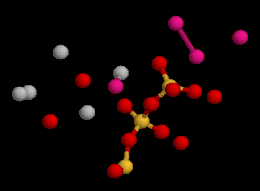| Jennite | |
|---|---|
 Crystal structure of jennite: elementary unit cell viewed in 3D | |
| General | |
| Category | Silicate mineral |
| Formula (repeating unit) | Ca9Si6O18(OH)6·8H2O |
| IMA symbol | Jnn[1] |
| Strunz classification | 9.DG.20 |
| Crystal system | Triclinic |
| Crystal class | Pinacoidal (1) (same H-M symbol) |
| Space group | P1 |
| Unit cell | a = 10.56, b = 7.25 c = 10.81 [Å]; α = 99.7° β = 97.67°, γ = 110.07°; Z = 1 |
| Identification | |
| Formula mass | 1,063 g/mol |
| Color | White |
| Crystal habit | Blade shaped crystals, fibrous aggregates, platy – sheet forms |
| Cleavage | Distinct on [001] |
| Mohs scale hardness | 3.5 |
| Luster | Vitreous (glassy) |
| Streak | White |
| Diaphaneity | Transparent to translucent |
| Density | 2.32–2.33 |
| Optical properties | Biaxial (−) |
| Refractive index | nα = 1.548 – 1.552 nβ = 1.562 – 1.564 nγ = 1.570 – 1.571 |
| Birefringence | δ = 0.022 |
| 2V angle | Measured: 74° |
| Ultraviolet fluorescence | Weak white |
| References | [2][3][4][5] |
Jennite is a calcium silicate hydrate mineral of general chemical formula: Ca9Si6O18(OH)6·8H2O.
Jennite occurs as an alteration mineral in metamorphosed limestone and skarn.[3] It typically occurs as vein and open space fillings as a late mineral phase.[5] It also occurs in hydrated cement paste.
A first specimen of jennite found in 1966 at the Crestmore quarries (Crestmore, Riverside County, California, US) was analysed and identified as a new mineral by Carpenter in 1966 (Carpenter, 1966). They named it in honor of its discoverer: Clarence Marvin Jenni (1896–1973) director of the Geological Museum at the University of Missouri.[3]
In contrast to the first analysis made by Carpenter, jennite was found to not contain appreciable amount of sodium when the Crestmore specimen was reexamined.[6]
The structure of jennite is made of three distinct modules: ribbons of edge-sharing calcium octahedra, silicate chains of wollastonite-type running along the b axis, and additional calcium octahedra on inversion centers. The hydroxyl groups are bonded to three calcium cations while no SiOH groups are observed.[7]
Jennite transforms to metajennite at 70–90 °C (158–194 °F) by losing four water molecules.[6]